Today’s hap is a rather special one. It is the work of Shetland designer, Donna Smith, who you may know as the patron of Shetland Wool Week, 2015, and the creator of the famous Baa-ble hat. Donna’s hap was inspired by her great auntie Emma Isbister, a wonderful knitter, who has been making Shetland haps for many years. During my research for this book, Donna took to me to visit Emma, who kindly talked to me about her knitting. You’ll find her hap construction methods (along with those of many other Shetland hap makers) discussed in a special chapter in the book.
Donna’s design is named Houlland, after the the croft on Shetland’s west side where Emma once lived. The design takes Emma’s favourite lace motifs (such as the tree and brand iron edging) and combines them into what might be regarded as a contemporary iteration of what in Shetland was once known as a “fancy hap” (a hap knitted from finer yarn, and with a patterned centre, that might be worn for “best” or gifted on the occasion of a new baby). The motifs in Donna’s hap have a long history, but she deploys them in the clean, structured and modern way that is characteristic of all of her designs, to create a hap that is beautifully decorative while remaining functional and wearable. The yarn used is Jamieson & Smith Shetland Supreme 2 ply lace weight , which comes in a range of beautiful natural sheep shades, and which was developed with the Shetland Museum and Archives to match the characteristics of the yarns used many decades ago by Shetland lace knitters like Donna’s great auntie Emma.
I caught up with Donna recently to talk about her hap.
KD You were patron of Shetland Wool Week in 2015, for which you designed the Baa-ble Hat pattern (which knitters all over the world have made). I wondered if you could say a few words about your experience of being patron, and the importance of Shetland Wool Week generally?
DS Being Patron of Shetland Wool Week last year was an amazing experience, I got to meet so many inspiring people and I have learned so much about how the hand knitting industry works. It has also opened up so many exciting opportunities for me, ones I wouldn’t have had if I hadn’t had this this role. The Baa-ble hat pattern was a huge success, far more than I ever anticipated. It was so encouraging to hear from knitters who were making it and it was their first time knitting with more than one colour or it was their first ever knitting project, that was really what I wanted to achieve. Shetland Wool Week is such an important event in Shetland’s calendar, it is an event that celebrates Shetland Wool and all the crafts associated with it as well as highlighting the importance of textiles within Shetland’s heritage. Shetland Wool really is such a good product and it is important that it is shown to a wider audience. It’s also a great way to bring people together that have an interest in textiles and to encourage new people to try out knitting. A few years ago it seemed as if the traditional techniques used in Shetland knitting was going to be lost as only the older generations were knitting and it wasn’t being carried on by younger people. Now, things are much better and there is a resurgence in the interest in the knitting and traditional crafts, this is partly due to events such as Shetland Wool Week.
KD Your design is inspired by your great Auntie Emma Isbister, a hap knitter. Could you tell us a little about this remarkable woman?
DS Auntie Emma has always been a very inspirational person. She is one of those women who can do anything and isn’t afraid of giving things a go. She worked as a nurse in her younger years and brought up four children; it was while she was waiting for the arrival of her first child that she knitted her first Shetland lace hap and has knitted countless haps since then as well as other lace garments such as cardigans and scarves. Can you believe she can knit a full sized lace hap in a week! Much of her work has been done for orders from personal customers, knitwear agents as well as gifts for family members – she made a lace hap for my son when he was born almost five years ago with lace croft houses in it which makes it a very special thing indeed. The amazing thing is that all of her work is done from memory, nothing is written down (unless she is designing a new lace pattern, such as the croft house design, and she will dot it out on graph paper), she just instinctively knows what will work and what won’t work.
KD Your hap is called Houlland — the name of the croft where Emma grew up on Shetland’s west side. Many people have little idea about what the landscape of Shetland is actually like — could you describe Houlland for them?
DS The first thing that many people notice when they visit Shetland for the first time is the lack of trees, particularly in the country areas. Houlland was a very typical croft (a croft is a small farm), a small house located in a fairly barren landscape.
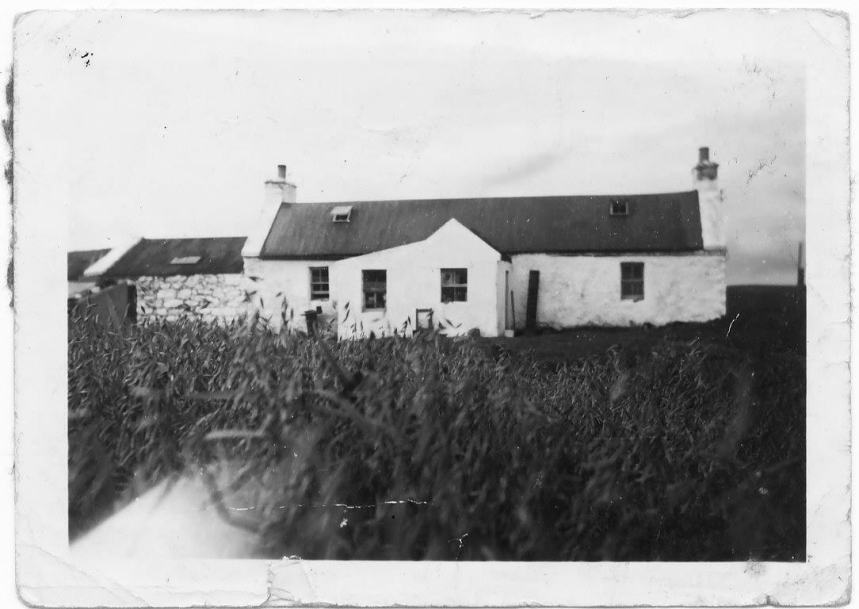
(Houlland, when Emma lived there)
. . .They kept animals such as sheep and hens and grew a few vegetables such as potatoes, kale and carrots. The weather in Shetland, combined with the salty sea air can be very harsh, making it very difficult for things to grow in areas with little shelter. The family lived off their animals and crops, and the women in the house knitted garments to supplement the income from the croft. A van selling groceries came around once a week and the knitted goods were sold and then the money was used to buy goods such as tea, flour and sugar. Auntie Emma remembers knitting spencers (long sleeved garter stitch undergarments) when she was a young girl and going out to the van to sell them. It’s very easy to romanticise the life they had at Houlland but in reality it was very hard.
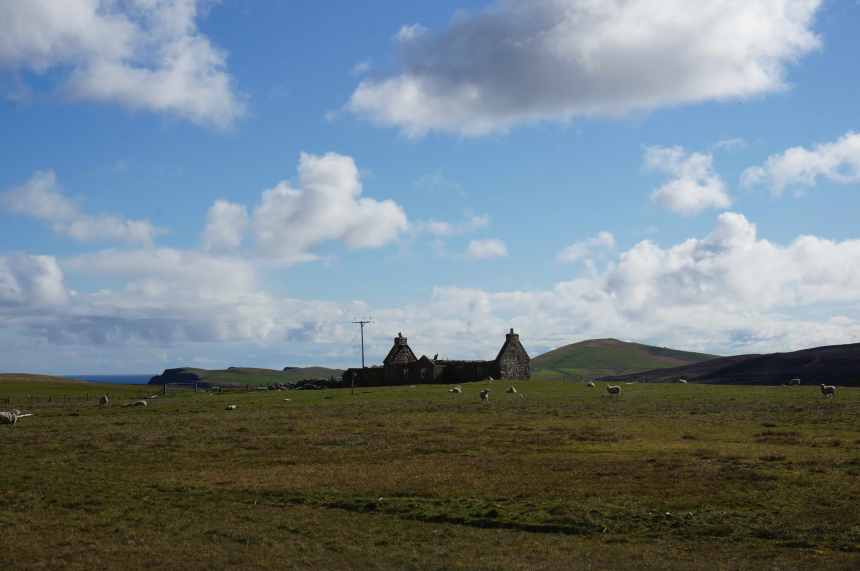
(Houlland today)
KD I’m interested in your process when creating a design. I always start with a finished look in mind (which I think may be a little unusual). What is your usual starting point?
I work in a similar way I think, I very often get an idea for a garment that I think would look good with a particular dress or outfit and then I work backwards. I have a vision of a finished item in my head but then I have to try to recreate it! Other times I get an idea for a pattern or colourway, maybe from fabric, or a pile of stones or a pattern in a book and think that would look good on a certain piece of clothing.
KD You’ve created art and design work in many different media, from felted fabric to knitted stitches. I feel that, whatever medium you are using, your work has an immediately recognisable aesthetic – and I wondered how you would define your signature style?
I like geometric and simple shapes, I have never been into frills (much to my Mam’s disappointment!), I like clean lines, pattern repeats and neutral colours so naturally that comes out in my work whatever the medium is. I find symmetry and straight lines very pleasing although you would never guess that when looking at my messy desk!
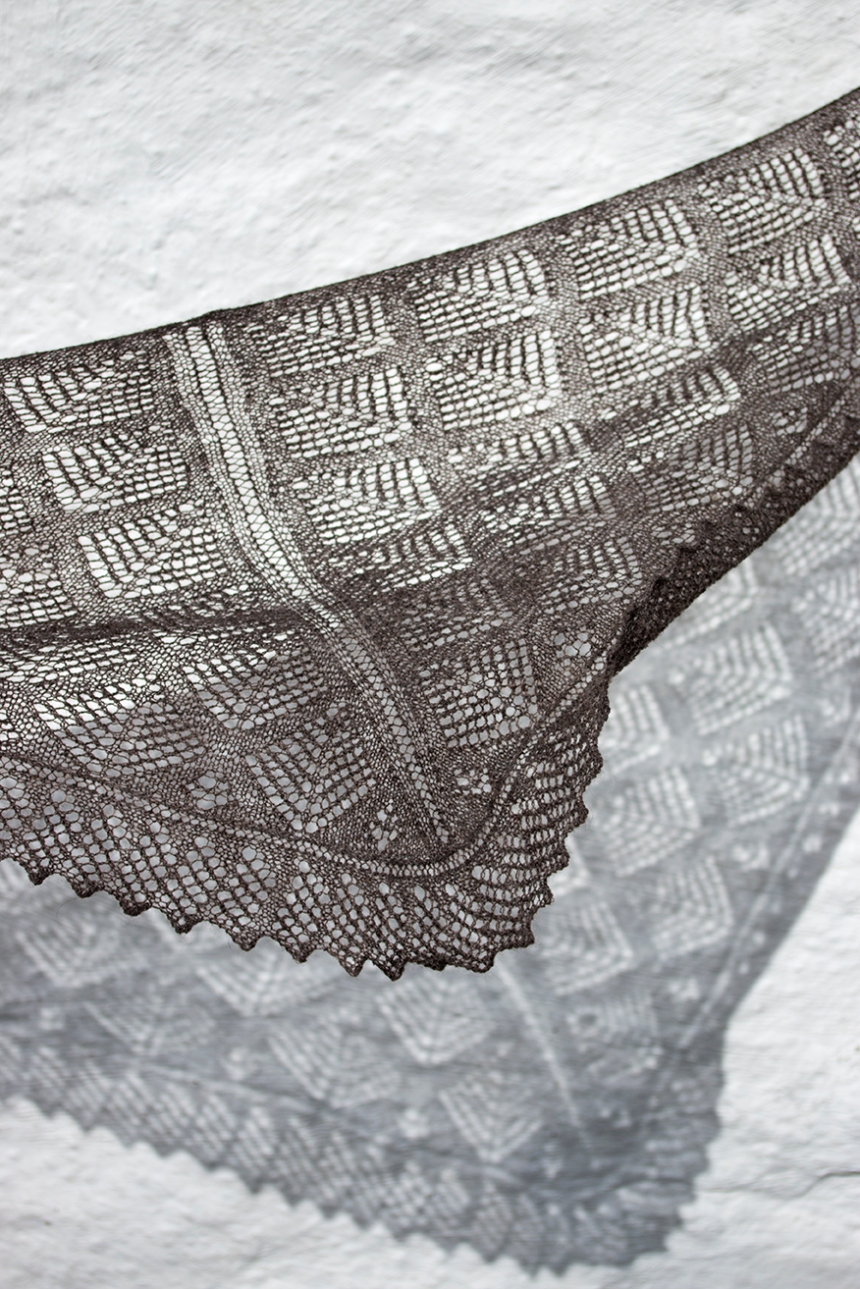
We took these photographs with Donna on a typically changeable (but beautiful) Shetland day.

The building is the baptist church at Sand, from which you can see the location of Emma’s croft at Houlland.
It is a wonderful place.
Donna and I thought you might also like to see these photographs of Houlland, being worn by Emma, who inspired it.
The cardigan Emma is wearing was knitted more than 70 years ago, and she adapted it from a waistcoat by knitting on new sleeves
Thankyou, Emma, and thank you Donna, for your beautiful, thoughtful design which speaks to Shetland knitting’s past and future!
Tomorrow’s hap design will be revealed over on Jen’s blog! You can see all haps currently revealed on Ravelry and pre-order the book here (next week I hope to be able to show you the exciting sight of the book coming off press at the printers!)


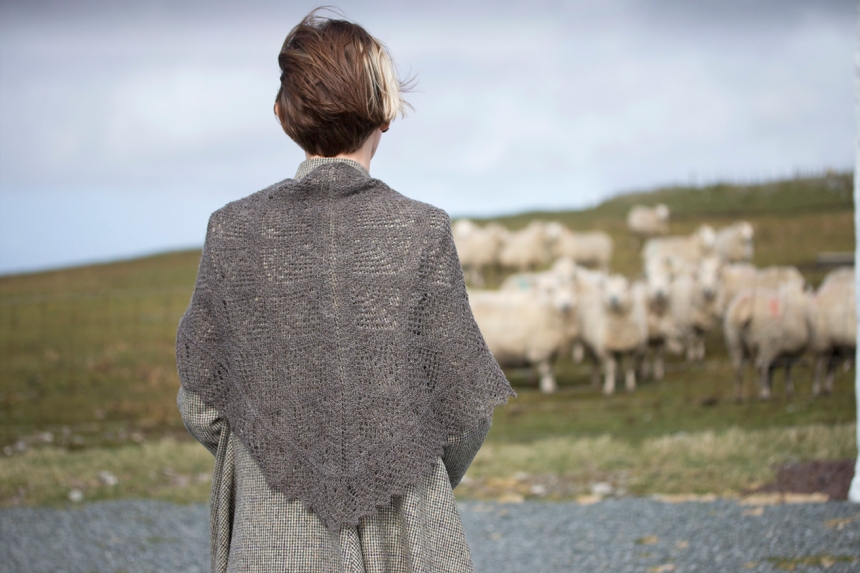
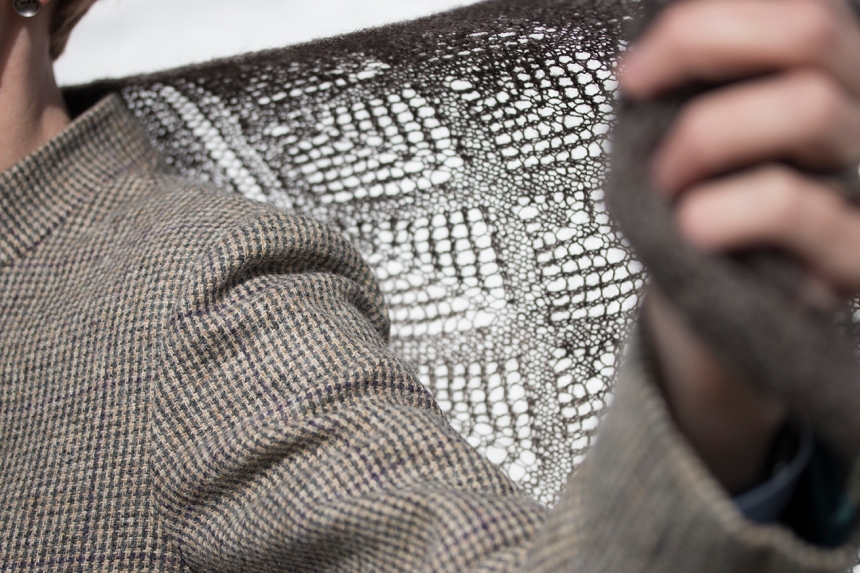
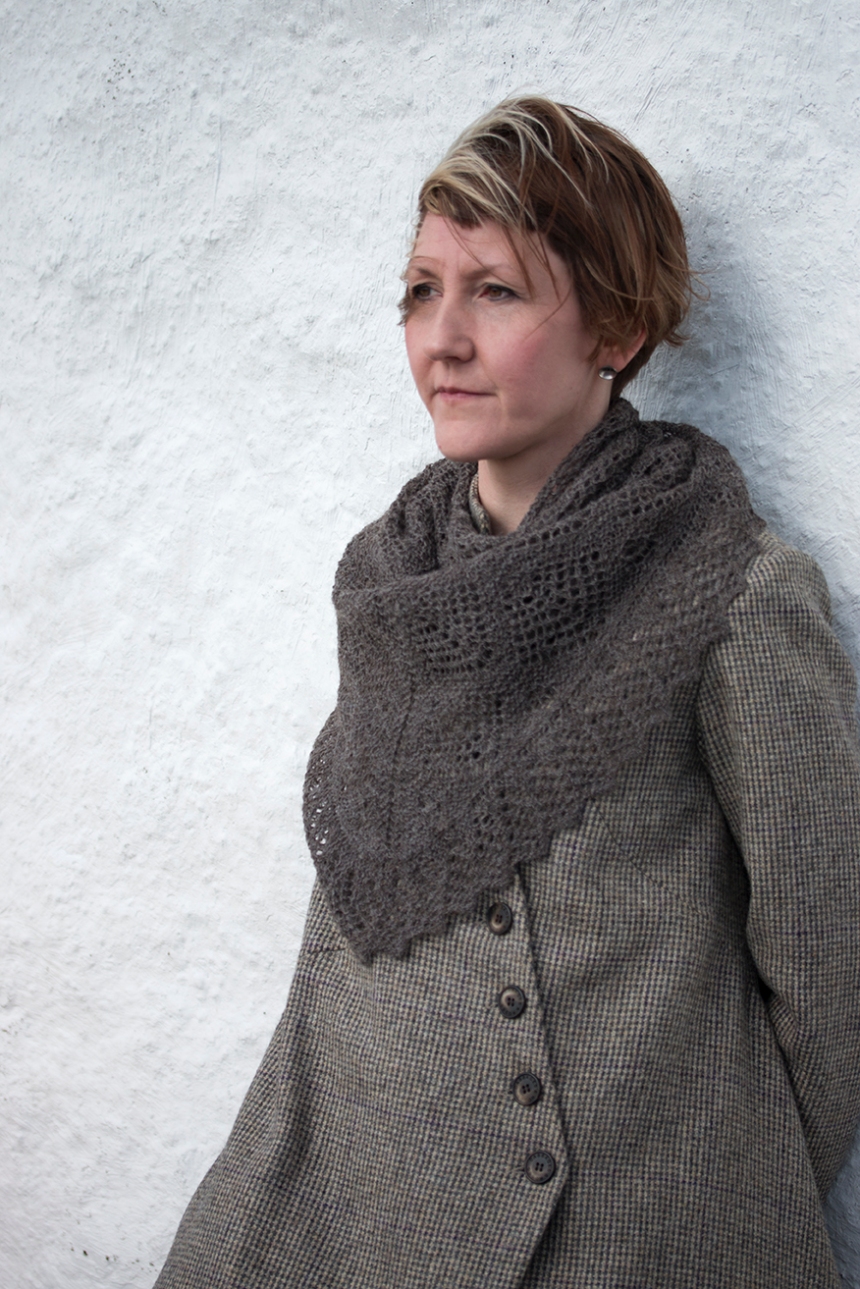

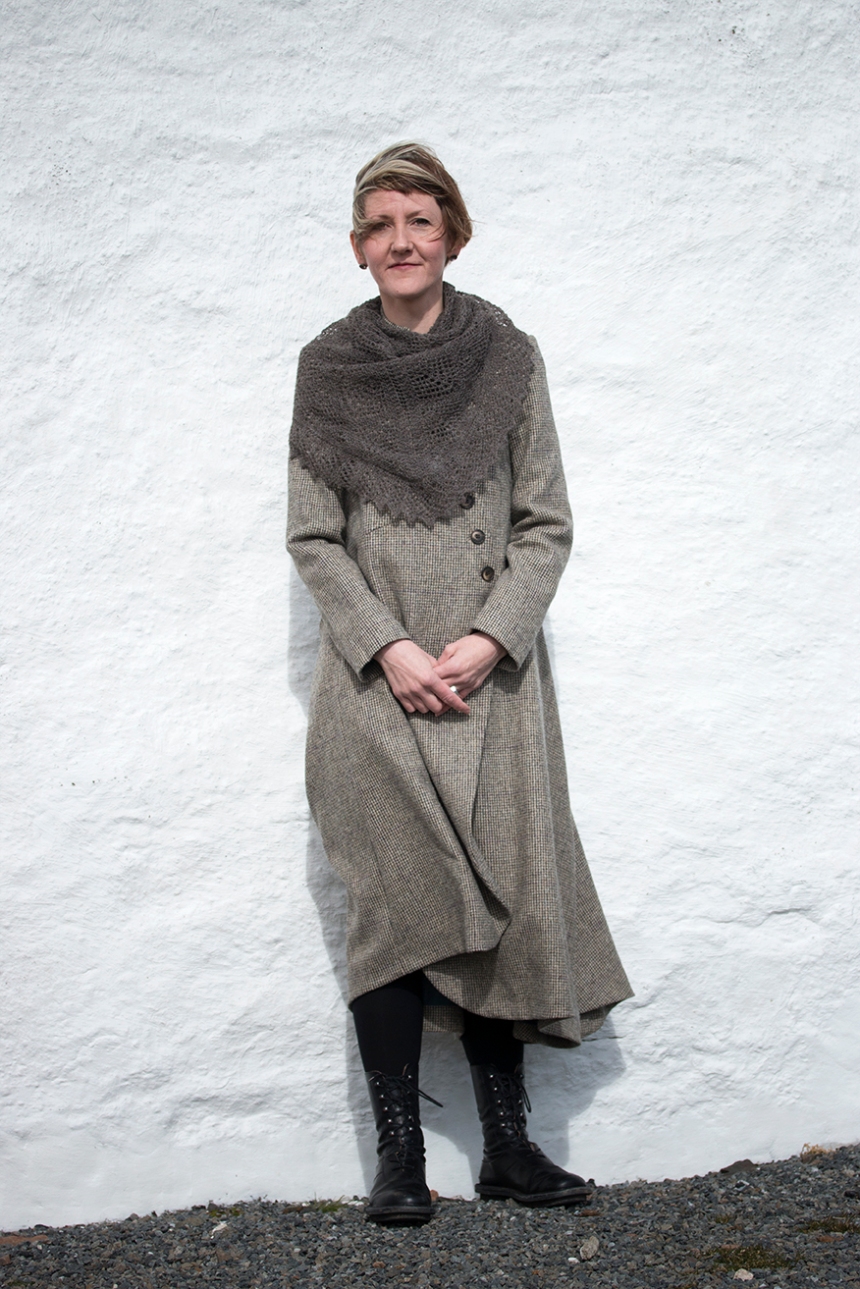
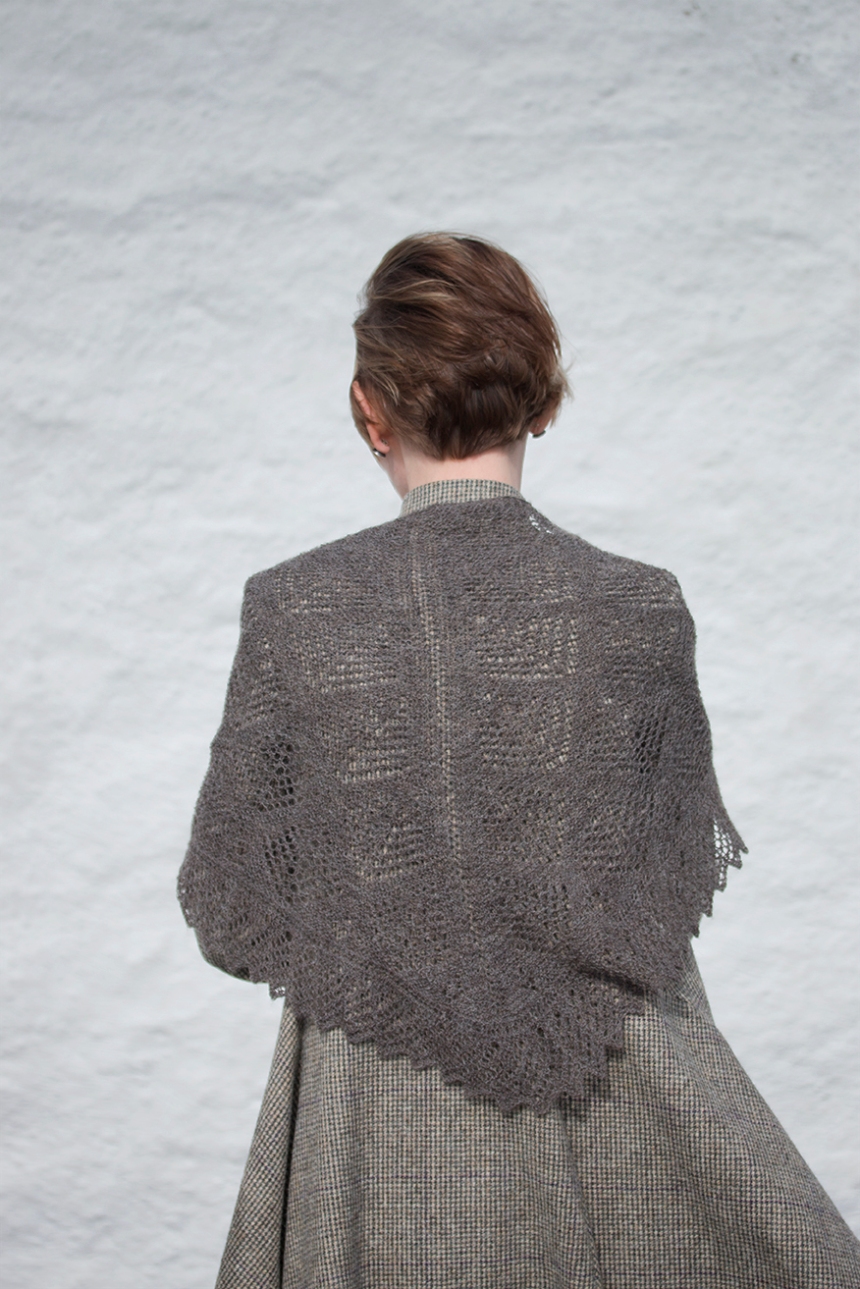
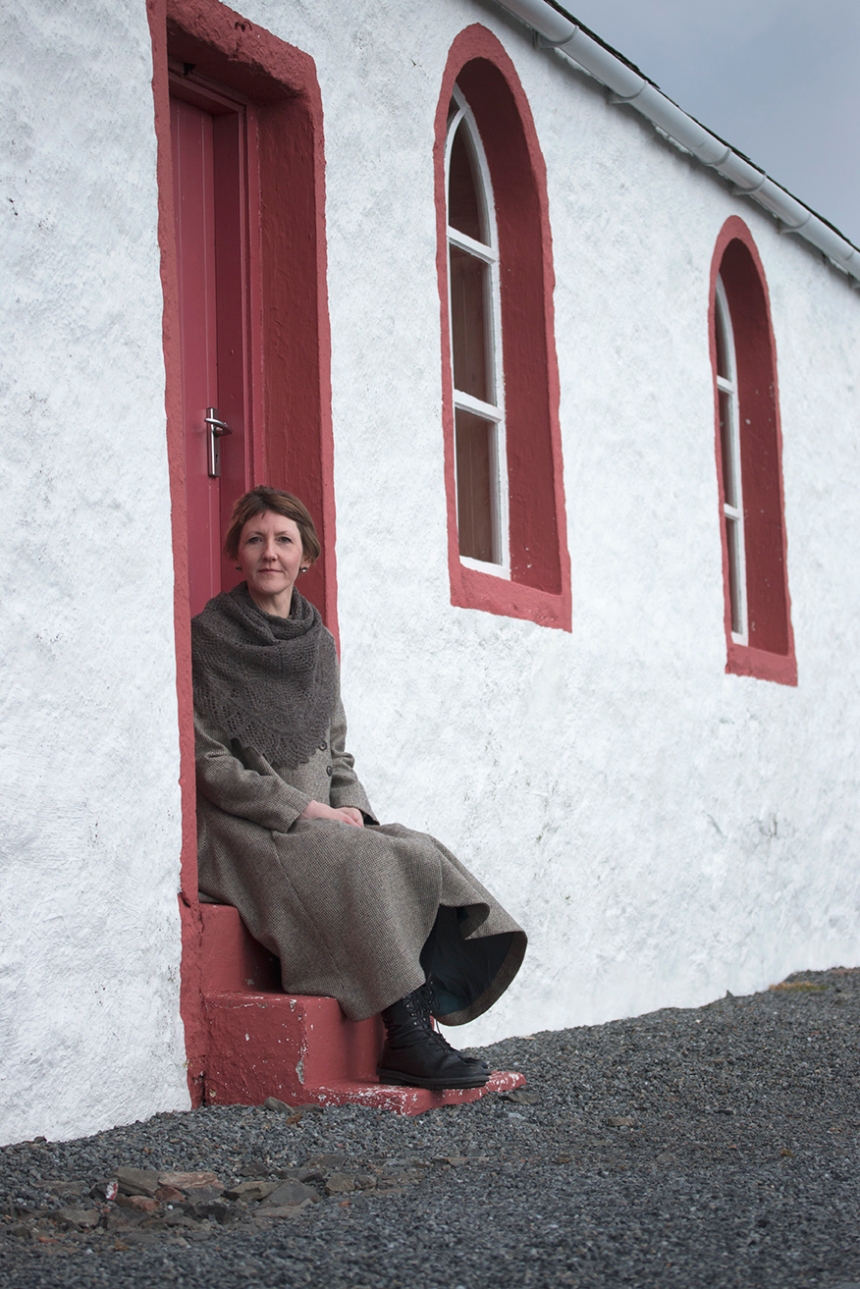
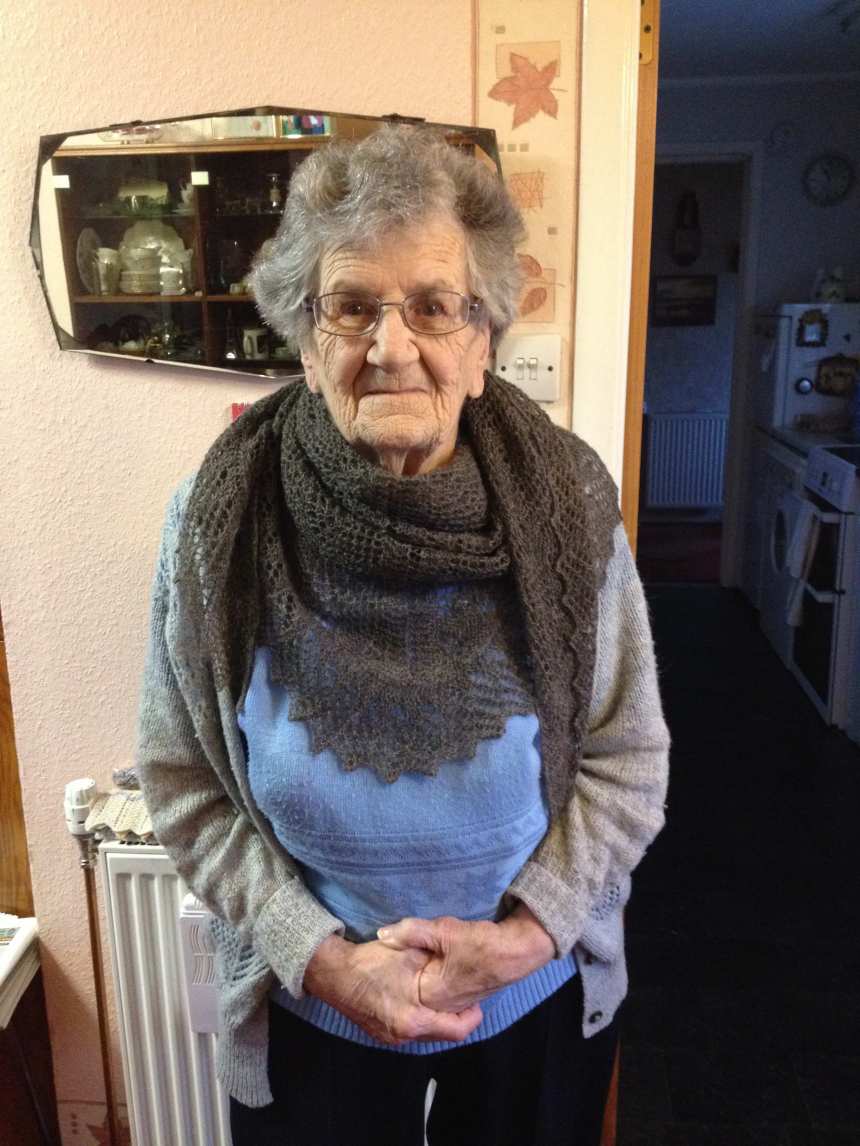
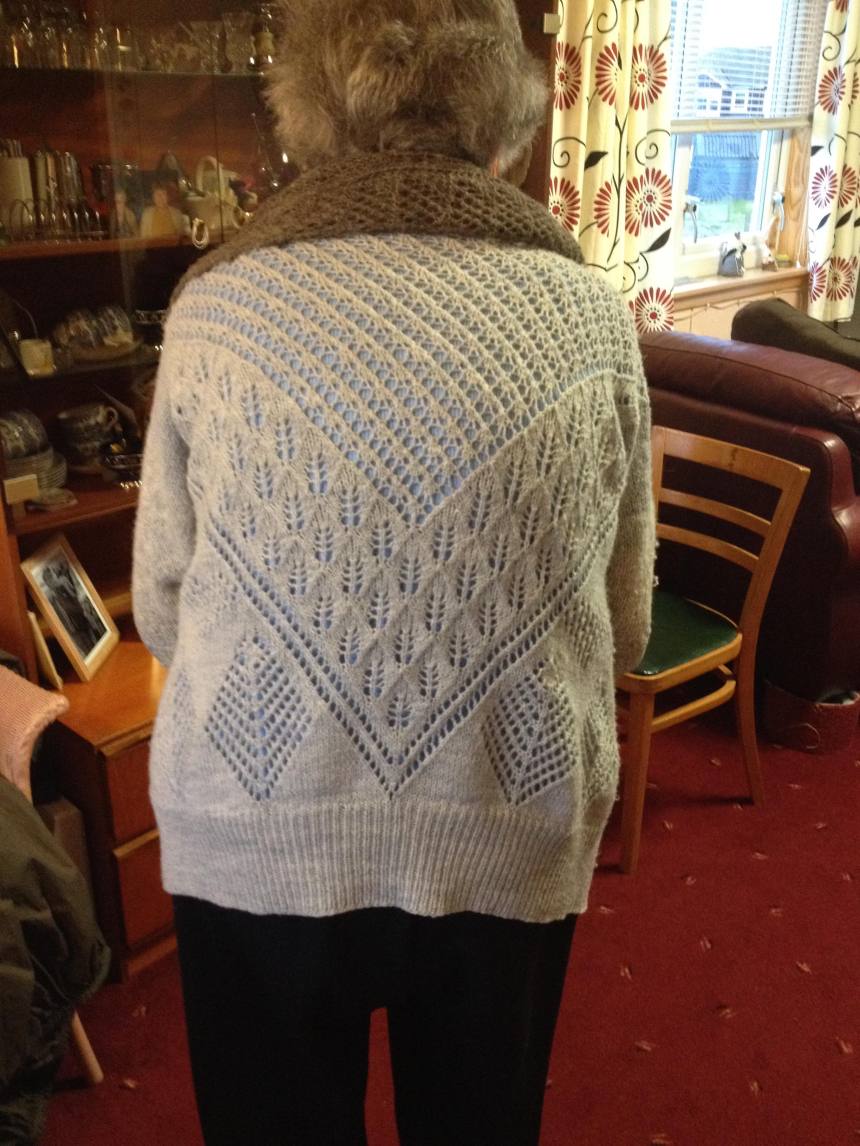
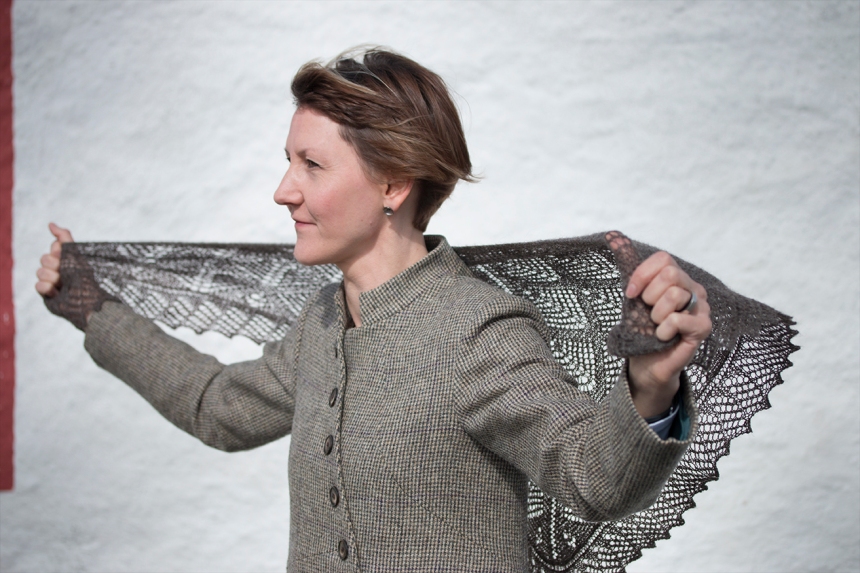
I’ve been looking for quite awhile for a shawl pattern that would do justice to the wonderful plant-dyed laceweight yarn I bought from Hespa (Gudrun Bjarnadottir) in Iceland. I think this is it!
LikeLike
This is just amazing! Such an inspiration!
LikeLike
My husband watched me try on a lace cardigan made by Emma at the museum in Scalloway. “Well, it fits you perfectly; you can’t leave it here.”. He was right! The lace cardigan is a treasure! I’m so delighted to learn more about Emma and to see her lovely face in this post.
LikeLike
Such an inspiring lace pattern. I love this design. And the story behind it is so interesting. Generations of women living under hard conditions – real heroines. The photos are beautiful. I like the coat, too. Who designed it?
LikeLike
This one is speaking to me….I’ve ordered the yarn, can’t wait to see the book.
LikeLike
Stunning! Thank you, Donna for such a gorgeous hap design ~ and for sharing the history with us! And Kate and Jen, thank you for bringing this book with these beautiful designs and stories to us! Picking a favorite is impossible :-)
Hugs to Emma ~ Your sweater is amazing!
LikeLike
All the time I am enjoying these posts about happs and I cannot wait for the book to arrive!!!
I do have a question: where did you and Donna bought those gorgeous coats? Good luck with the busy times ahead Johanna
LikeLike
So well done – all of it – the designs, the styling, the interesting back stories. Thank you!
LikeLike
Beautiful shawl but, like so many others already, I want that coat. Where’s it from?
LikeLike
Compliments to the photographer. Lovely photos but especially the one of the hap and its shadow. It could be enlarged and framed it is so beautiful. I agree with all the comments so far. I want to knit all the haps you have shown us to date but I will start with this one. And I can’t wait to read more of the history. Would love to sit and knit in Shetland with Emma, Donna, you, Jen and all the other wonderful knitters. It seems a long way away from Ottawa, but maybe one day :) Thanks again for all your work.
LikeLike
I just pre-ordered a copy of the book! After seeing the designs so far it’s not one of them I don’t want to knit! Thank you for such a lovely book! Best Regards from Sweden!
LikeLike
Wow, so evocative. The vernacular has such grace and strength. Beautiful pattern, text, photographs, people, place. A perfect diversion for Friday morning at the office. Such rapid change in the last 50 years, to see a small bit of continuity of craft and culture is hopeful. Now I want to unplug this weekend – drink tea (or maybe whisky), plant sturdy veg (I have a lot of tiny kale & cabbage seedlings and seed potatoes waiting), and start knitting a piece of lacework (only one lace shawl so far).
LikeLike
This hap is so gorgeous! And, may I please say that Emma is adorable and I’m sure an absolute treasure. Thank you for the photos of her, the crofthouse, the designer-with-hap, and the great Q&A!
LikeLike
Just beautiful
LikeLike
Where to start? Echoing all of the above. AM TOTALLY TORN between the first one and this magnificent
work……..and then there is the COAT! Thank you for the inclusion of Emma and her history. Lovely, just lovely. Nice work Donna.
LikeLike
Loving everything about this design – and post! Thanks to you, Donna, and Emma for the insights into a history and beauty that I certainly admire, but need this context to begin to understand. Feeling SO many connections between this family and my own, who once had a small farm in the southern U. S.
LikeLike
Let me add my voice to the chorus of those saying how much we are enjoying these daily posts! This one is the best yet, especially the photos of Donna’s Great-Auntie Emma. My order for the book is already in, but I may have to print out this post and tuck it in the back of the book.
LikeLike
This is my favorite Hap so far, as I love trees. And the family story behind it makes it even more special. Thanks Donna, Emma, and Kate for sharing it.
LikeLike
This was a lovely post, with the history of Emma’s haps and the picture of her and her home.
LikeLike
Oh, and how could I forget…Emma is darling and her sweater is stunning and very much in vogue — still! I love sweaters with open patterns!!!
LikeLike
You talented women are making this incredibly difficult…I’m going to have to flip a coin to decide which one to begin first…this hap is absolutely exquisite, and in my always favorite comfort color: grey. And again, the styling and photography is off of the charts. I might have to recreate Donna’s coat in my workshop!
LikeLike
So far, I think this is probably my favourite. Will certainly be the first on the needles, as I’ve already got some of the yarn waiting (knew it was a good idea to lay in some stock when I was in Shetland last summer)…
LikeLike
A beautiful post, just beautiful.
LikeLike
Your haps are marvelous, but people have already been telling you that! I would like to comment on how remarkable the COATS are, as well! The styling of the photos, the settings…..makes me wish I were right there, too.
LikeLike
This hap has really captured my fancy. Love it.
LikeLike
Perfect! Light, lacy, airy, yet still with a hit of “rustic” and natural! Emma’s sweater is wonderful too! Our society is so “throw away”, that the idea of a 70 year old cardigan is amazing.
I love the coat. I’d love to have one like it!
LikeLike
I can’t wait to knit Houlland! I love the tree design. Especially given the fact that there are so few trees on Shetland, I think people must use the design to make up for that. This pattern will be my first lace project with actual lace weight yarn. Thank you, Donna, for sharing your family’s history with us. When I saw that now Houlland is now in ruins, I feared that Auntie Emma had passed. I was so happy to see that she is still with us and still such an important part of Shetland’s knitting community. I hope she will not mind, but I simply must copy her cardigan. Thank you, Donna, for giving such a beautiful hap to us. Thank you, Kate, for gathering such a wealth of knitting history and patterns to us in your wonderful books. And thank you, also, to Auntie Emma for being a source of inspiration to carry on Shetland’s grand knitting traditions.
LikeLike
Omigosh! This is the best posting you’ve done yet, with the best photos, and maybe the best hap! Thank you Emma, for your inspiration! Kate, can you persuade Emma to offer her cardigan pattern for sale?
LikeLike
Another reader wanting to know about the gorgeous coat/dress. Please share?
And thank you, Kate, Donna, Emma, and the designers and knitters who have brought us this book.
LikeLike
wonderful story, photos, and hap. Shetland and it’s knitters are amazing. I must go there someday.
LikeLike
My favorite…so far :-).
LikeLike
Beautiful, Shetland lace at its best.
LikeLike
Lovely Hap. Lovely pictures and lovley story. Thanks to Emma and Donna.
LikeLike
Houlland did it for me, the book is ordered! I must knit this hap and give it a home in Norway by using the lovely Røros Lammeull garn (lambs wool yarn) by Rauma. The story about Emma was wonderful. I really adore the way you teach us so much about textile history when you present your designs and books. You are a truly talented woman, dear Kate Davies.
Hopefully you will take a look at Norwegian knitting traditions sometime?
LikeLike
This was so interesting! Thank you, Kate. We have been to Shetland, and long to go there again.
Sent from my iPad
>
LikeLike
Hi Kate, you and Donna are mind readers ! I really wanted to see pictures of Emma in the hap too, she looks lovely. Thank you.
LikeLike
Echoing ladies above. Beautiful hap the colour of a moody Shetland sky or the rocks heading down to sea. Like the others I also love Donna’s coat!
LikeLike
Gorgeous hap. Am going to make this one definitely! I was lucky enough to meet Emma Isbister at Shetland Wool Week last year. She was knitting in Scalloway museum with some other ladies and I spent a very memorable afternoon with her and the other ladies knitting with them and discussing knitting and the Shetland dialect! Emma sells a lot of her lovely work in the Scalloway museum if anyone is going this year, do have a look, its beautiful. My husband got a gorgeous photo of Emma that day. Image here :https://www.flickr.com/photos/sbell/21195753243/in/album-72157659137460545/
LikeLike
this is a wonderful photograph – thank you!
LikeLike
My pleasure!
LikeLike
Can’t wait to see the book… your pictures speak a thousand stitches and I want to get started! I particularly like Houland, and Emma is one grat lady!
LikeLike
Yes a really stunning pattern which particularly appeals to me. I love the story , seeing the waistcoat to cardigan and I love Donna’s coat. A super start to my Friday – thank you.
LikeLike
What a beautiful woman Auntie Emma. I love elderly women’s hands (including my mum’s, whose hands I have photographed several times): the love and care they have had for their families shines out strong.
LikeLike
How sad to see Houlland roofless and ruined. I must go to Shetland, your photos are very compelling.
LikeLike
How sad to see the croft as it is today. I want to buy it and put the roof back on.
LikeLike
Another lovely design that speaks so much about the designer and their life and background. Thank you for giving us a picture of Emma as well. She looks so much like my gran that I got a little misty eyed. My gran taught me to knit and has worked hard in a rural community all her life. She’s a painter and quilter and knitter and seeing those photos and reading about Emma made me very homesick for my gran all of the sudden.
LikeLike
Having visited Shetland from Australia last year and (very briefly) met Donna, and knitted the BaaBaa Bobble Hat, I am thrilled to see her Hap presented here – I also love Donna’s coat! What a gorgeous style, did she make that as well?
LikeLike
That is just beautiful and will be first on my list to knit, I think. Who knows what tomorrows Happ will bring?
LikeLike
Emma … so glad you included her photograph. She looks charming, as though you could spend hours hearing stories from her.
LikeLike
Wonderful in everyway. My favourite design so far! I think I must be traditionalist….. in my choice of hap design.
LikeLike
Oh, it’s beautiful, I MUST knit Houlland! Donna’s coat dress is gorgeous too.
LikeLike